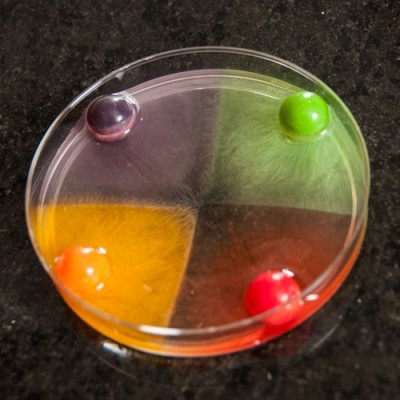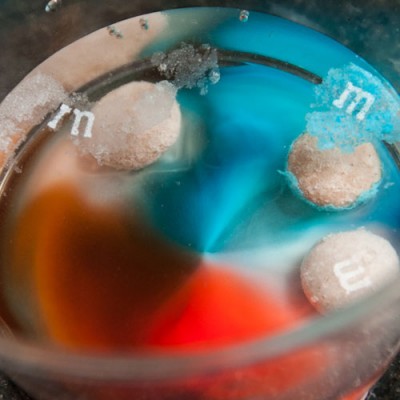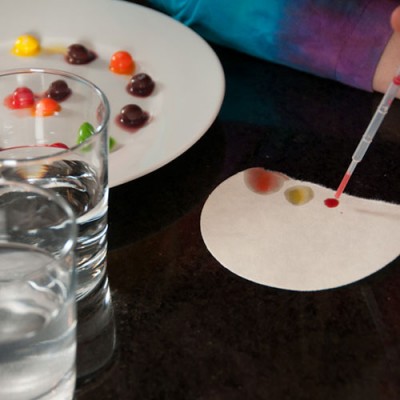Colorful Dissolving Candy Kitchen Science
By Blog Editor Susan Wells
There are several classic candy experiments making the rounds on the Internet, so I thought I’d try a few with the kids to see if they really worked.
Dissolving Gobstopper Experiment
First, we tried the Gobstopper experiment. This one is perfect for budding scientists who like to guess or hypothesize about what will happen before you start. Gobstoppers have at least four layers of different flavors, so this experiment gets really fun.
Start by filling a petri dish halfway full with water. Then add four different colored Gobstoppers on opposite sides. Observe what happens. The colors do not mix but instead create sharp edges and stop. This is a simple science fair experiment for young children – you can mix up the experiment or change the variables, by using different types of dissolving candies, like Skittles, Lifesavers, etc, different types of liquids like soda, milk, water, etc or by changing the temperature of the water. What will dissolve the candy faster? Cold or hot water?
This is also a fun activity to try using different amounts of candy. What happens where there are two or three in the dish? Does it still make colorful shapes?
Floating Letters Experiment
Next, we tested the edible ink on candies like M&M’s and Skittles. If you carefully drop the candies letter side up in water and wait. The candy shell dissolves but the ink does not. It floats to the top, usually intact.
Candy Chromatography
Colorful candies like Skittles are made with FD&C dyes, sugar and other substances. Chromatography is a technique used to separate different parts of a solution. It is used to identify chemicals, used to identify crime scene samples like blood or drugs and used to demonstrate the different dyes in your favorite candy.
In this experiment, you will dissolve the colored candy shell on M&M’s, Skittles or Gobstoppers, drop the colored water on filter paper and observe how far each color moves across the paper. This is also a fun and easy science fair experiment. You can compare the dyes in different candy shells to see if they are the same or different.
Water will travel through paper by a process called capillary action. As the water travels,it picks up particles and carries them through the paper. This is called paper chromatography.
Chromatography works because different parts of a solution, like the water-dye solution you drop on the filter paper, will move differently and at different rates. Some will “stick” to the paper fibers and not spend a lot of time traveling with the water, while others will travel in the water for greater distances. Different dyes will move varying distances.
Filter paper works well in this experiment, because it allows water to flow through it easily.
Thank you to CandyExperiments.com for the Floating Letters experiment idea.
For complete step by step instructions and the science behind all three of these experiments, visit the Colorful Dissolving Candy Experiments page.







this is cool
Dissolving Gobstoppers is very fun, I’ve tried it as well. There’s an explanation for it in my upcoming book Candy Experiments, and you can find more candy experiments at my website, http://www.candyexperiments.com.
I just purchased Loralee’s book. It has so many fun experiments with the explanations. Great resource for summer fun with my kiddos. Thank you!
By the way, I love the Gobstopper experiment!! My kids love it, but so do my adult friends!!!
Nice experiment I really want to try this
Nice!
Wonderful post. Thank you for the great ideas for my classroom. My kids will absolutely love these delicious Science experiments!
UHHHHHHHH YOU A TEACHER
u funny
What will edible ink dissolve in?
awesome!!!!!
Cool ,that gave me ideas for my science project! Try doing in which drink does jolly rancher melt the fastest in !!!!!
AWSOME!!! GET A INSTAGRAM
love it!
I love that
I need a COLORFUL candy such as gobstoppers or skittles to throw on snow, sand, the street, wherever, that must dissolve quickly so nobody has to cleanup. Any suggestions?
[email protected]
I’d suggest Gobstoppers. They do dissolve fast and are very colorful. I’d also suggest doing a test to make sure it doesn’t stain or cause any other issues. Good luck!